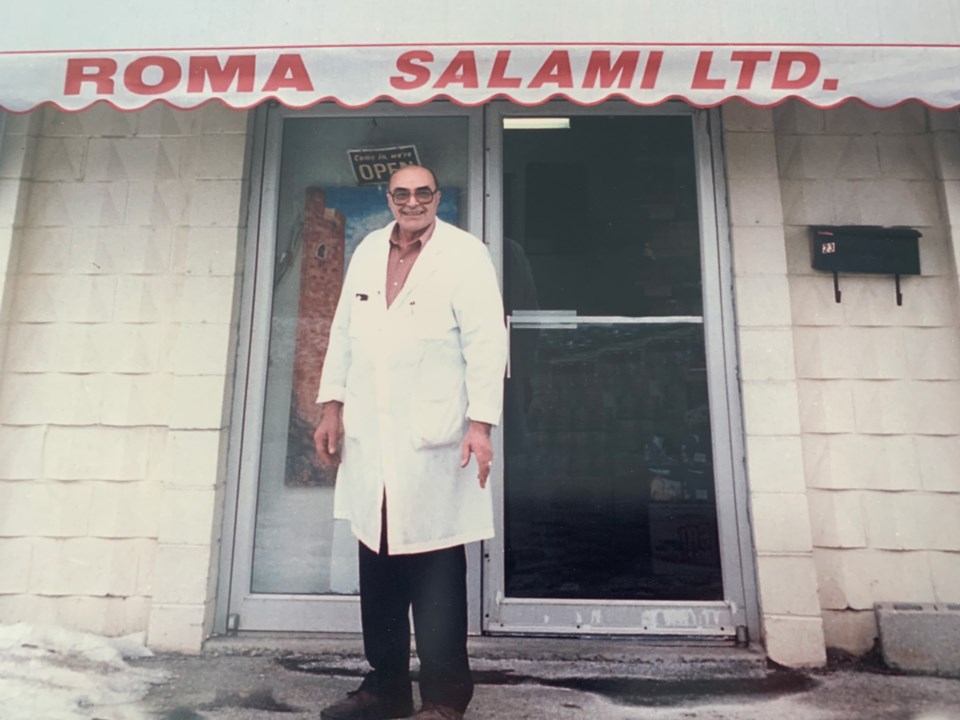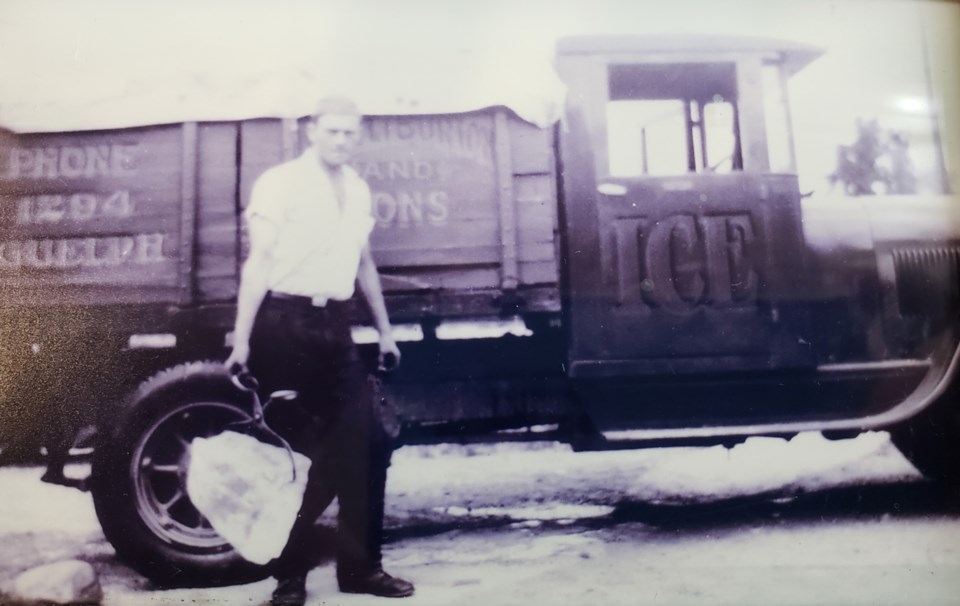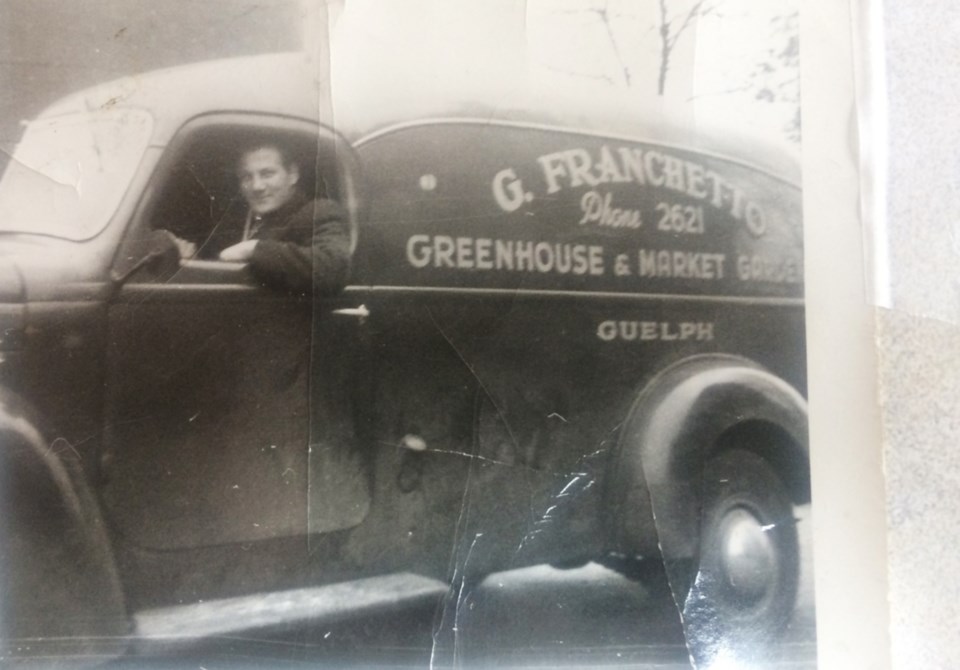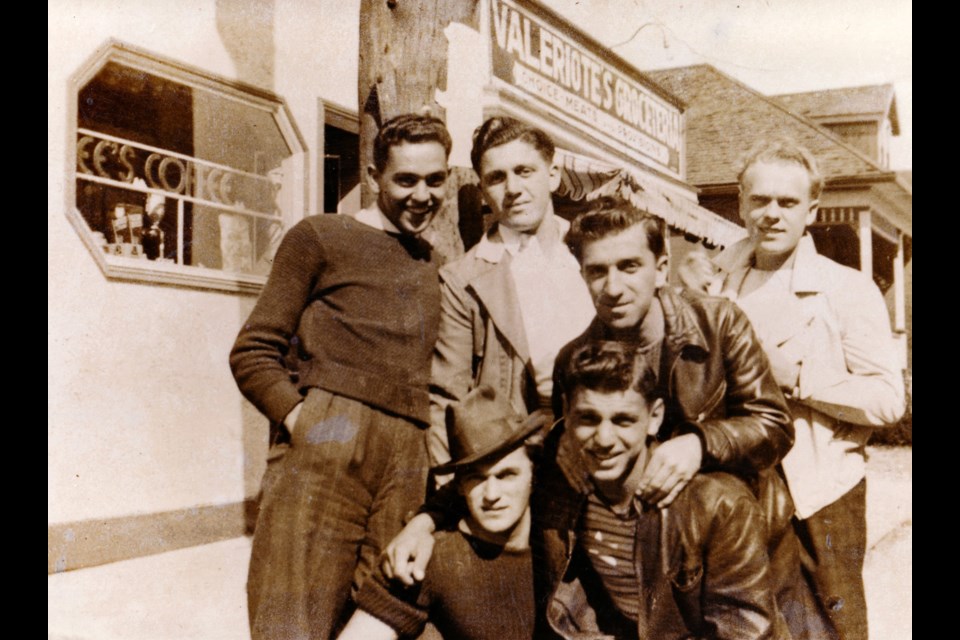“If you were ever desperate for food, you could knock on any door in the Ward…day or night ... and get help. Many of the grocery stores would even let you put your bill on a tab without ever having to worry about paying interest.” – Palma Valeriote
Today you would likely be arrested if you knocked on anyone’s door at any hour of the night to get food in any town or city and we would hardly be allowed to rack up a credit card bill or make a purchase without paying interest.
But in the late 1940s and 50s a strong, unbreakable bond emerged in St. Patrick’s Ward, a special Italian community in Guelph where everyone looked out for one another.
Many were born and grew up around Morris, Ferguson, Elizabeth, Metcalfe Street (renamed Huron Street in 1956) and Alice Street - the Heart of St. Patrick’s Ward and Guelph’s Italian community.
The largest group of these Italian store owners in the Ward came from Treviso, near Venice in Northern Italy and to the south from Reggio, Calabria, especially from San Giorgio Morgeto in Italy’s toe.
Many others, like my Dad, Dominic Tersigni, and his brothers Joe, Luciano, and Antonio came from Frosinone in the Lazio Region of Central Italy.
The Ward had an economy all its own. There were stores on just about every corner where people went to socialize, eat, drink, play cards, listen to music, buy groceries and just hang out.
 Tranquillo Baggio. Submitted photo
Tranquillo Baggio. Submitted photoDuring these decades, most people did not have a car and walked to local grocery stores, butcher shops, coffee bars, variety stores, and bakeries. It is hard to imagine today, but most grocery stores during these decades never opened on a Sunday.
The restaurant opened from 9 p.m. until 2 a.m. and featured a second floor with a jukebox and wooden dance floor. Angelo Longo and Gino Tersigni worked there as waiters and said there was a makeshift food elevator that allowed workers to hoist food trays up by rope to the second floor.
For little more than 60 cents patrons could enjoy a plate of homemade spaghetti with Dominic’s own pasta sauce and meatballs. Boston cream pie was one of their featured desserts. A Chinese cook named Henry was a long-time employee and worked with Dominic in the kitchen.
As teens, Richard Gazzola and Hugh Peloso remember going for hot chocolate at the Spaghetti House after CYO dances in the basement at Sacred Heart Church.
Dominic’s daughter, Lucy Ferraro Morabito, said The Spaghetti House attracted people from all over Ontario and some from as far away as New York state.
Jazz great Lionel Hampton and his band also ate at the Spaghetti House after playing late night shows at the old Paradise Gardens on Woodlawn Road.
In the heart of the Ward was Valeriote’s Groceteria and Sub-Post Office #5, run by Dominic Valeriote and his wife Loyola. Dominic’s parents, Elizabeth and Michelangelo turned the store over to him in 1933 and Dominic operated the family business at 134 Alice St. until 1975.
Because of Italian tradition and family history, there were four Dominic Valeriote’s in Guelph at the time, and so with such stiff competition for his given name, Dominic decided to call himself “Dee.”
The store sold everything, from a full stock of groceries, fresh produce, beer and candy, to cigarettes. It even ran a full-time butcher shop.
Most people in the neighbourhood did not own cars, so Dee delivered the groceries in his station wagon.
Like many other grocery stores in the Ward, Dee always extended credit to families who could not pay right away.
Valeriote’s Groceteria had been the hub of Guelph’s Italian community for nearly 50 years. In the evenings, when the weather was bad, many Italian men in the Ward would gather inside the Coffee Bar and in good weather under the streetlight in front of the groceteria.
Dee Valeriote was a strong advocate for Catholic Education in Guelph and served as a Catholic School Board trustee for 46 years. He was also a court translator and a Commissioner of Oaths. Quite an accomplishment for a kid from the Ward who had a big heart and only a Grade 7 education.
Angelina and Gerunsio Peloso began a small grocery store called ‘Pelosos’ at 20 Stevenson St. in 1933. Pelosos Market was a Guelph landmark for almost 30 years. Their daughter Hiole was a driving force behind the early success of the store before becoming a well-known and respected teacher in Guelph.
In the early years of the store they would deliver groceries by bicycle in good weather and then toboggan in the winter.
Aside from selling their own groceries and produce, Pelosos also supplied hamburger patties to the University of Guelph and steaks to the Aberfoyle Mill.
Hugh Peloso jokingly remembers one incident where thieves broke into the store and stole a huge leg of beef. The meat was so heavy that the thieves could not carry it very far and Guelph Police found it a short distance from the store near Empire Street.
Pelosos grew to become the biggest grocery store in St. Patrick’s Ward. The family business was sold in 1980 and is currently run by Angelinos.
Imagine having milk in glass bottles and delivered to you by horse and wagon. That was the way it was in the 40s and 50s.
The Ward had two Dairies. The Crown Dairy at 26 Toronto St. was run by Mac and Irene Robertson and the Victoria Dairy at 119 Ontario St. next to Tytler Public School was operated by Harry Harmer.
The milk was brought in by trucks from outlying dairy farms in eight gallon cans and then pasteurized and bottled at the local dairies.
Palmira Vincentine, who lived across the street from the Crown Dairy, still remembers the sound of the noisy trucks lining up to deliver the milk.
Bruno Franchetto was one of the last to drive the Belgian horses and wagons delivering milk for Crown Dairy. My brother Ralph often worked for Bruno on Saturdays and was paid 25 cents and given a pint of chocolate milk.
 Kelly Halliburton delivers a block of ice. Submitted photo
Kelly Halliburton delivers a block of ice. Submitted photoAfter work on Saturdays, the horse was put out to pasture on Franchetto’s farm, now Franchetto Park, on Victoria Road. Even the horse had a day of rest on Sundays.
Crown Dairy began in 1942 and is still in business today and is run by Mac Robinson’s son, David, on Elizabeth Street.
Hard to believe today, but customers would often pay by putting cash inside the empty bottles of milk that they would leave at their doorstep. Jack recalls a quart of milk costing 10 cents.
There was never any need to clean up the mess left after the delivery horses and wagons travelling throughout the neighbourhood. People would use coal shovels to scoop up the horse manure (often called horse buns, horse hooey, horse chips or horse pucky), mix it with water, and then feed their vegetable and flower gardens.
There were two bakeries in the Ward. Umberto ‘Berto’ Paneghel operated his bake shop at the corner of Elizabeth and Stevenson streets. Berto, well-known for his Italian bread recipe, was the baker and his brother Victorio handled delivery in a green panel van.
Richard Gazzola, who grew up near the bakery, remembers Berto wiring up the battery in the delivery truck in a clever way so that if someone tried to enter the van to steal his bread they would get a surprise shock.
Joseph ‘Joe’ Dominic Veroni had a small Bakery shop on Alice Street. After closing the shop, Joe really made a name for himself in the city. He was an Ontario Champion wrestler, boxer, and a trainer with Guelph’s junior hockey teams. Some of his home remedies for various aches and pains are still talked about in the sporting world today.
Aside from Valeriote’s Groceteria, there were many small grocery, variety and coffee stores on just about every corner in the Ward.
Dee Valeriote’s brother-in-law George Zimmerman and his wife Pearl ran Dee’s Coffee Bar on Alice Street. Fred Fazzari opened a small grocery store on the northeast corner of Alice and Metcalfe streets. At the corner of Morris and Alice streets was yet another grocery store run by Sam and Rose Sorbara. Further down Alice Street the Siminato’s ran their General Grocery Store.
Palmira Vincentine remembers Albert Cremasco riding his motorcycle around the neighborhood buying fresh lettuce and other vegetables from her garden and several others in the neighborhood to sell in his grocery store at the corner of York and Victoria Roads.
Harley (Cliff) and Marion Elsley opened their grocery store and post office at the corner of York Road and Brockville Avenue in 1944. Cliff sold the store in 1971 because the Trudeau government brought in the metric system. He wanted nothing to do with converting over to the new system.
The Embro family was heavily involved in the grocery business in the Ward. Jimmy Embro and his wife Rosena began their family grocery store at the corner of Wheeler and Ferguson streets. Their two sons, Sammy and Louie Embro followed in the family tradition and opened a grocery store at the corner of Elizabeth and Huron Streets beside my dad’s Dominic’s Barbershop.
In the late 1950s, Sammy Embro and his wife Carmel took over the store on Elizabeth Street. He sold everything from regular groceries, fruit, candy and sandwiches to bread and milk. During the Halloween season Sammy made delicious red and caramel candy apples.
In the winter he would sell Christmas trees in his parking lot behind the store. A third brother, Trieste Embro, sold fish and chips, hot dogs, hamburgers and sodas at his store on Arthur Street.
Want something sweet like a honey dip donut? No problem because you could easily get it in the Ward. Mavis Zuccala, who had a great reputation for cooking, sold home-made honey dip donuts with her husband Ralph from their home on Ferguson Street and door to door throughout the neighbourhood.
St. Patrick’s Ward also featured the first Italian meat processing company in Guelph and only the second in Ontario to produce and sell salami, sausage and other meats to retailers throughout the province.
Starting with a small hand grinder, Tranquillo Baggio opened Roma Salami on Garibaldi Street in the early 1950s. Tranquillo’s daughter, Elisa, remembers her dad experimenting with hundreds of pounds of meat for nearly five years, perfecting his own special recipe for sausage and other kinds of meats.
Tranquillo was an innovator when it came to food processing and was committed to his customers, even to go as far as supplying meat to the Guelph Farmers Market and then making a salami delivery to Peloso’s Market on the morning of his wedding.
Hugh Peloso vividly remembers Tranquillo showing up with the salami order that Saturday morning.
“Aren’t you getting married today?” Hugh asked.
Tranquillo laughed and replied: “I still have an hour to shower and change.”
Tranquillo Baggio’s passion for food and promise to produce a quality product brought great success to a business that ran for nearly 50 years.
There were several butcher and meat shops.
Joe and Mary Gatti ran a popular grocery/meat store at the corner of Elizabeth and Morris streets. Joe was the butcher and Mary ran the storefront counter. I remember going into Gatti’s many times to pick up a few groceries and my mom allowing me to buy a Wagon Wheel for a few pennies.
You could always smell the freshly ground coffee from Louis “GiGi” Carere’s full-service Grocery Store on Alice Street. The store operated from 1944 to 1958 and specialized in fresh meats, fruits, vegetables, canned goods, bread, milk, donuts, and coffee. GiGi was a butcher who was well-known for his home-made pork sausage.
Joe Molto always had fresh chickens hanging in the window at his butcher shop at the corner of Alice and Huron streets. Joe was an old-fashioned butcher who had many customers from outside the city.
Jack Lovelock was another butcher and with his wife Rita operated their meat shop with an accompanying grocery store at the corner of Neeve and Richardson streets for almost ten years.
Palmira Vincentine, who is 99 years old, still has a set of pots she bought at Quarries Grocery store at the corner of Ontario and Short streets. The store was originally owned by the Husson family and was bought out by Jack and Kate Quarrie in the early 1960s and was called Quarrie’s Lucky Dollar.
Kate Quarrie was Guelph’s 41st mayor and only its second female mayor. Palmira says she will never part with the set of pots.
A short distance away at 69 Ontario St was yet another meat and grocery store run by the Laidlaw brothers. Jim Haughton operated his Meat/Grocery shop at the corner of Elizabeth and Huron Streets that was later taken over by Rudy Ryder in the 1950s.
The Ward also featured its own slaughterhouse operated by Charlie Barber and his family at 41 Elizabeth Street.
The Butcher Shop in front of the Slaughterhouse was a saving grace for many people who could not afford the more expensive cuts of meat. Charlie would often hand out little brown bags of candy to kids in the neighbourhood.
 The Franchetto delivery truck. Submitted photo
The Franchetto delivery truck. Submitted photoHorses and wagons and later trucks and vans were always winding their way through St. Patrick’s Ward during these early decades delivering other goods like fish, ice, vegetables and pop.
My sister Oliva clearly remembers Angelo Valeriote, with his familiar handlebar mustache and big smile, pushing a two-wheeled cart, filled with fish packed in ice, coming down Ferguson Street. Valeriote’s granddaughter, Shirley Strisler says her grandfather would pick up the fish on Saturday mornings at the train station in Guelph. The fish, Baccala (dry salted cod Fish) was imported from Boston.
The delivery of ice to the Ward and other parts of Guelph dates to the late 1900s when John Halliburton began the Halliburton and Sons Ice Merchant Company.
Most people could not afford a fridge so perishable food was stored in an insulated ice box (also called the cold closet) that was usually made of wood and lined with tin or zinc.
In the winter months, the Halliburton’s cut blocks of ice from the Speed River at the end of Clarence Street and later from a pond at Ignatius Centre on Highway 6.
In the early 1950s, the Franchetto family on Elizabeth Street were the largest vegetable growers in Guelph. Every Friday, Pete Franchetto would load up his green and white wagon pulled by his white farm horse and deliver vegetables throughout the Ward. A bunch of carrots back then cost 25 cents. They also sold flowers and plants grown from their greenhouse at 170 Elizabeth St.
Driving the first Ford Truck in Guelph, Albert Reinhart, who operated Reinhart’s Beverage Company, delivered pop in wooden crates throughout the Ward. The Reinhart plant at the corner of Gordon and James Streets produced all flavours of pop from dry ginger ale, cream soda and root beer to lime rickey and flip. You could buy two 30-ounce bottles of pop for 39 cents.
My Dad would often buy the 30-ounce bottles, not for the pop, but just to get the bottles to use for his home-made tomato sauce. Me and three brothers, Ralph, Dominic, and Frank, still use those same bottles every summer when making our own family tomato sauce.
I will never forget filling up my dad’s Barber Shop cooler on Elizabeth Street with Flip. A seven-ounce bottle of Flip, with its familiar yellow cap, cost 5 cents. It was my favourite pop in the 50s.
At the tail end of the Ward on Elizabeth Street at York Road and still open today is the original Rocky’s Hot Dog Joint and Drive-In Restaurant.
Rocco (Rocky) James Contini first established the business downtown on Cardigan Street (Wilson Street) in 1948 and then re-opened on York Road in 1959 and then made the final move to 520 Elizabeth Street in 1960.
Aside from being a popular place to show off hot rods and motorcycles, Rocky’s main attractions were the foot-long hot dogs smothered in Rocco’s secret sweet relish, ‘real’ milk shakes and pop served in the original Pop Shoppe bottles.
The family business and tradition are carried on today by Rocco’s son, Ric.
It is amazing that over the decades Rocky’s has survived all the competition from the growth of fast-food restaurants in the city. What a testament to Rocco Contini, a young Italian kid who came to Canada with so little, but like so many other immigrant families in the Ward, worked tirelessly to make a better life for his family.
These store owners and their families did not have a lot of money, but they followed a dream and left a legacy in the Ward that will never be matched or forgotten.
They never took vacations. The only day they ever took off was Sunday for church and supper with family, relatives and often time friends. That was their vacation time. Plenty of home-made food, wine, and time with family … this was their most important tradition.
Lou Fontinato, who grew up in St. Patrick’s Ward, found fame as a hockey player with the New York Rangers in 1954. He had a typical childhood growing up in an Italian family on Ferguson Street.
I leave the final word to “Leapin’” Lou, who often expressed what living in the Ward meant to himself and so many others: “Weren’t we lucky to have been born in the Ward. Everyone down there had a work ethic that will never, ever, be matched.”
By Joe Tersigni
(The Tersigni families lived on Morris, Elizabeth and Neeve Streets in St. Patrick’s Ward)



